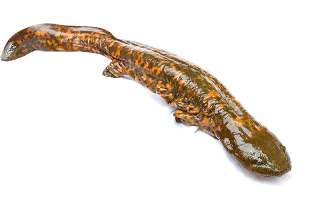Now a group of conservationists is giving the eastern hellbender a hand in the hopes of saving the wily creatures from extinction here. The hellbender (Cryptobranchus alleganiensis), Ohio's largest amphibian, can grow to two feet long, weigh nearly three pounds and live for up to 29 years. And the males, who guard their nests, aren't afraid to throw that heft around when confronted near their under-rock dens during breeding season, in late summer. "They can be rather intimidating," says hellbender expert Gregory Lipps, who has scoured Ohio River streams since 2006 in search of the few remaining hellbenders. After Lipps' research showed that hellbenders still breed here but most of the young fail to survive likely due to runoff from farm fields, several organizations began raising hellbenders to release them to the wild.
The Columbus Zoo and Aquarium, the Toledo Zoo, the Wilds in Muskingum County and inmates at the Marion Correctional Institute are raising hellbenders from eggs collected in eastern Ohio.
"We've learned to collect the eggs -- one female can lay 250 of them -- after the males have tended to them for two weeks," Lipps said. "The males fan them and eat the bad eggs, then we have more success with hatching healthy hellbenders a month or so later."
Greg Lipps, Ohio's expert on hellbenders, is leading the charge to reintroduce them to the streams they inhabited before pollution nearly wiped them out.
The Toledo Zoo has more than 700 young hellbenders, while the Columbus Zoo has 45 and the prison has a dozen, Lipps said, noting that the prison's holding facility could be expanded.
Two dozen 3- and 4-year-old hellbenders have been released into two eastern Ohio streams, where hellbenders were found in the 1980s then vanished with a rise in pollution. The streams have recovered to become some of the highest quality waterways in the state, according to the Department of Natural Resources.
The captive-born hellbenders are implanted with radio transmitters so biologists can track them as they feed on crayfish, fish, snails, worms and tadpoles in the spring and fall. They don't eat much, if at all, the rest of the year, and so far, 55 percent have survived, Lipps said.
Funding for the hellbender project comes from the U.S. Fish and Wildlife Service and donations to the Division of Wildlife's Diversity Program, the Toledo Zoo and the Columbus Zoo.
Source: Cleveland.com, 12 December 2013
http://www.cleveland.com/metro/index.ssf/2013/12/efforts_underway_to_br…

- Log in to post comments
